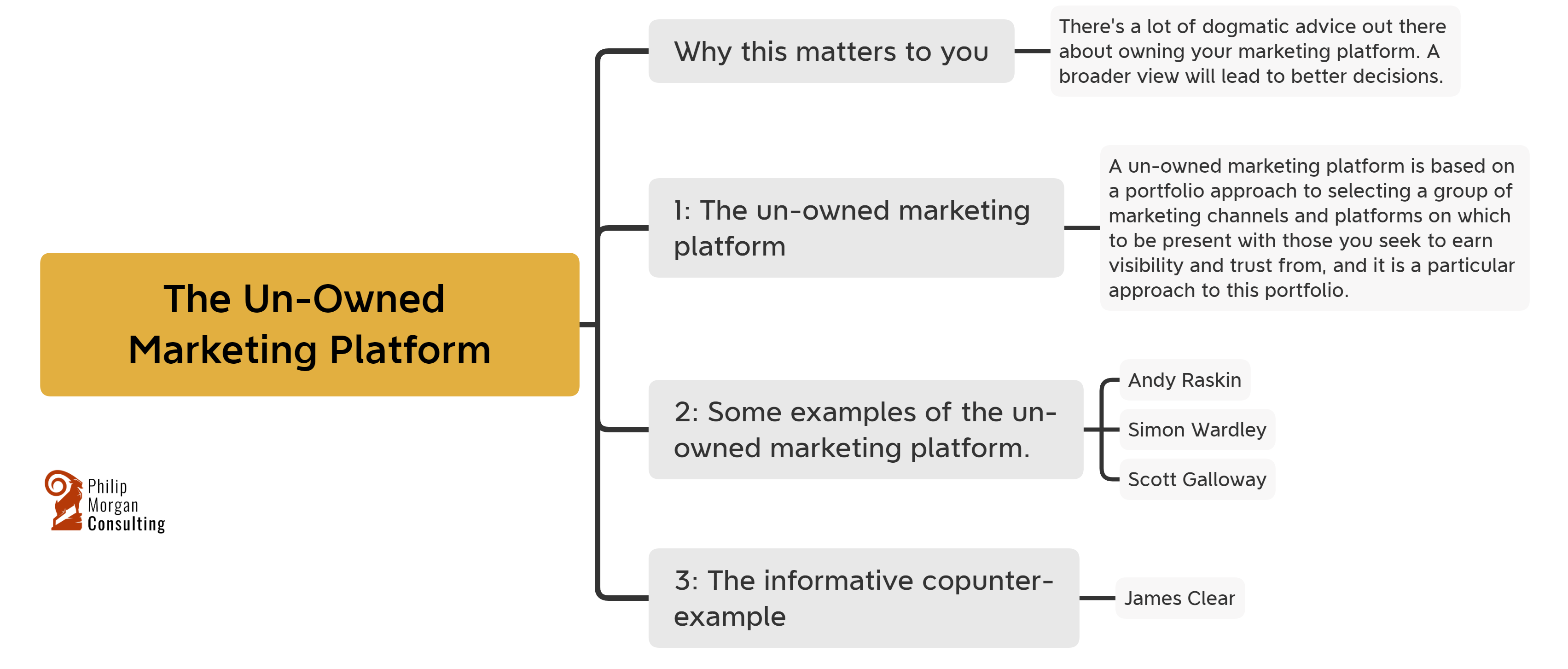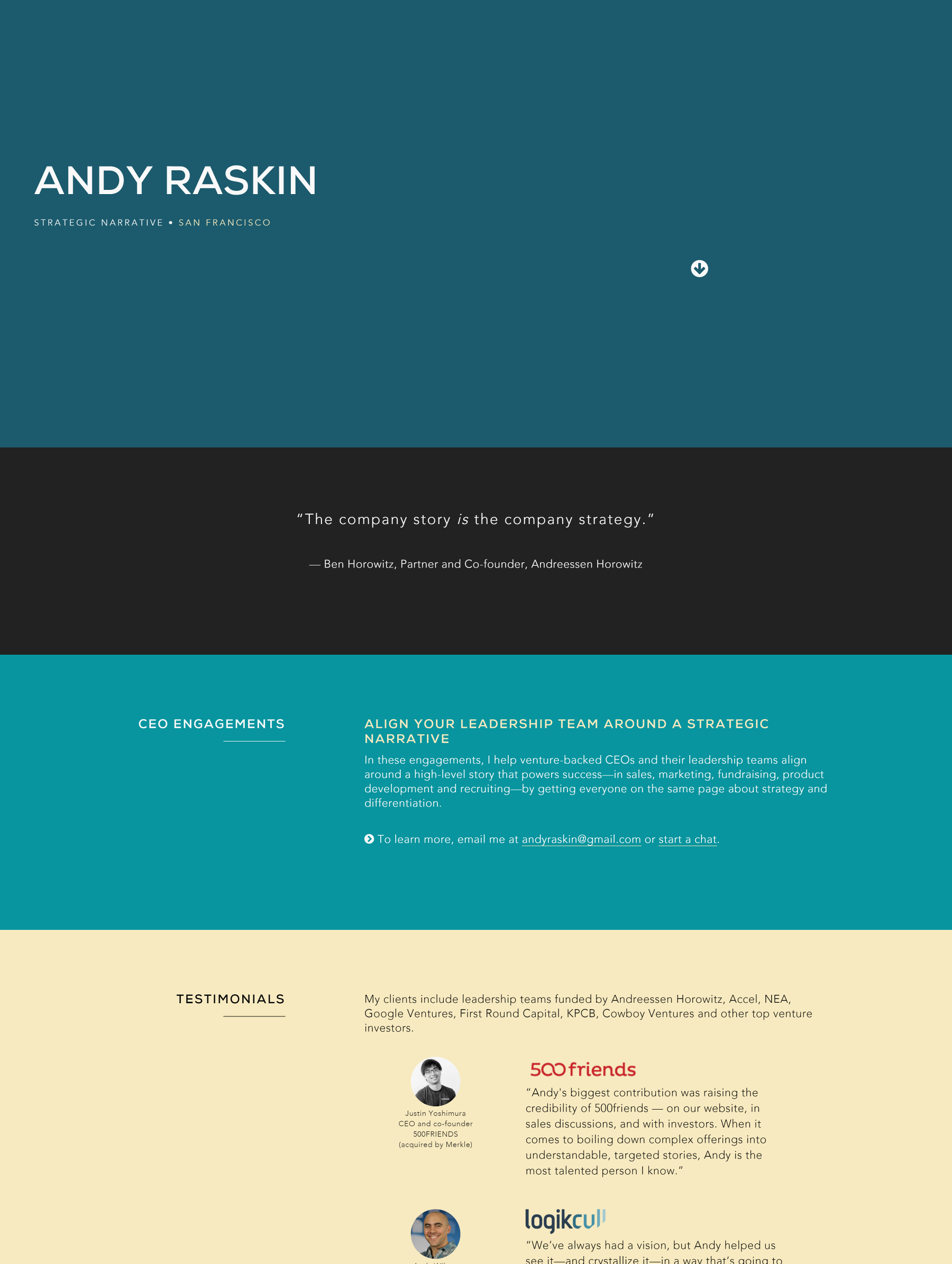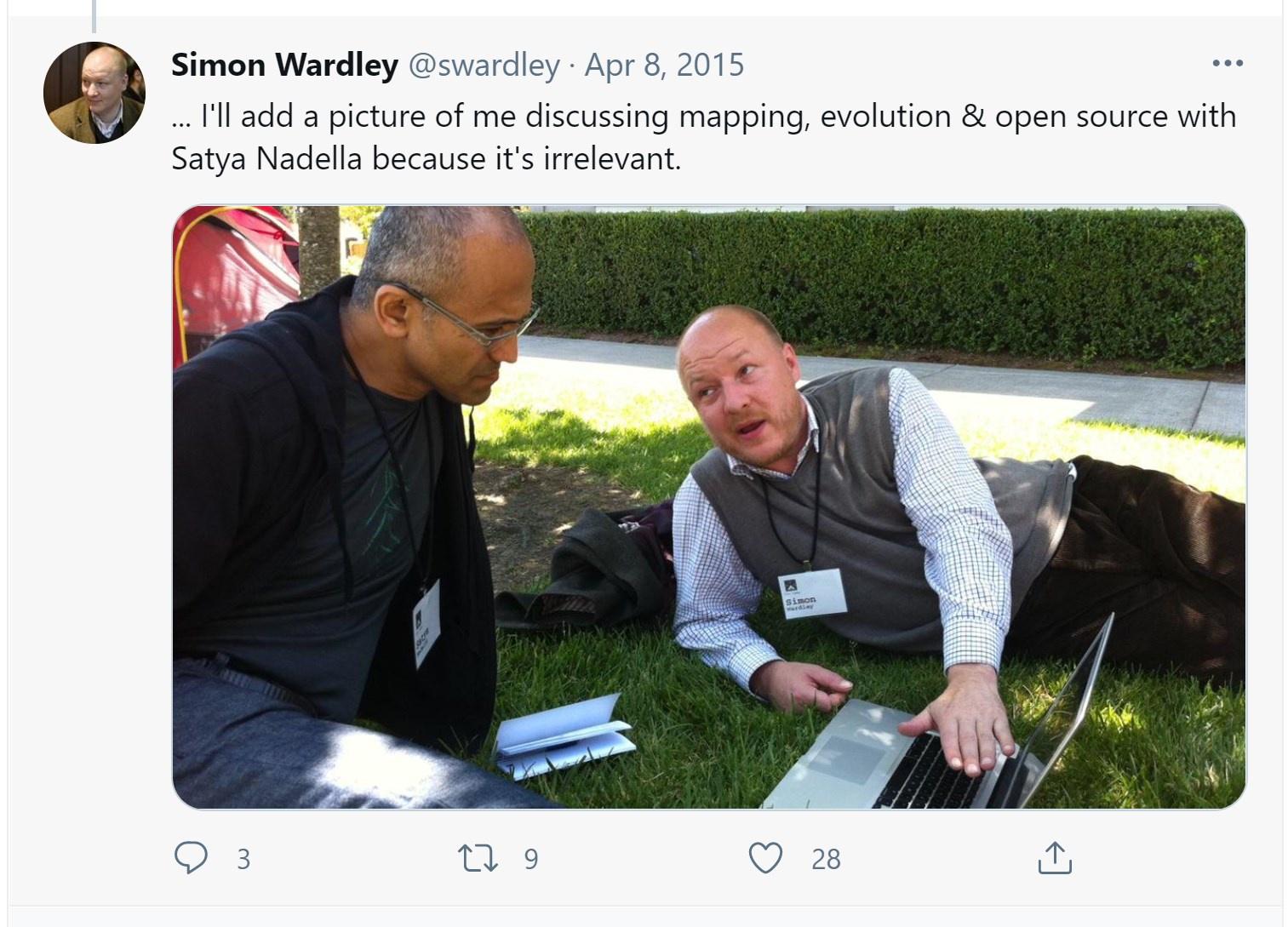The Un-Owned Marketing Platform
Why this matters to you: there's a lot of dogmatic advice out there from advisors or advisors+implementors who are under pressure to get you results quick. If we take a higher level, less dogmatic view, we might ignore their advice and build something better suited to our purpose because we starting thinking of building a system that seeks opportunity or impact rather than getting pigeonholed in building a site, a marketing funnel, etc. It's better when the tail does not wag the dog.
I'm going to describe something that, for lack of a better term, I call the un-owned marketing platform. There is a strong chance you — based on the specifics of your business and goals — should reject this approach to marketing. But at least consider it first so that you know whether a better website, a better marketing funnel, or a better whatever is what you really need. Choose from among all the options rather than the most recent one you've been pitched by someone selling a solution in search of a problem.

I'm going to start with the general idea first, and then talk through some examples. The first part might be a bit of a necessary slog, so strap in.
A un-owned marketing platform is based on a portfolio approach to selecting a group of marketing channels and platforms on which to be present with those you seek to earn visibility and trust from, and it is a particular approach to this portfolio.
The portfolio approach is the first part of this. Let's characterize some marketing channels to get a sense of how they might work together in a portfolio.
It's tradeoffs all the way down the line, isnt' it? :) If your approach to marketing has a purpose and you can embrace constraints, it's easier to choose from among the tradeoffs these different channels present. For example, if the purpose is to get cash in the door as quickly as possible and the main constraint is low cash outlay, then we might prioritize social media. If we change the constraint from low cash outlay to low time outlay, we might hire a good paid advertising firm to help us achieve our primary purpose.
Because no one channel has it all, we start thinking in terms of a portfolio. Some channels trade away our "ownership"[1] of the audience for greater reach. Others trade away the long, slow grind of developing a customer base for an ability to reach those who are ready to purchase NOW.
Gini Dietrich advocates a fairly balanced approach to making these tradeoffs, and this view is baked into her PESO model: https://spinsucks.com/communication/peso-model-breakdown/
The un-owned marketing platform does something that would horrify many marketers: it shifts the portfolio away from the Owned part of Gini's PESO model. If we have unlimited resources and no constraints, this is bad portfolio management. But… we never have unlimited resources and complete freedom from constraints. As a result, in some situations, not investing in the parts of marketing that we can "own" (primarily our website and email list) is good portfolio management. Or we might think of this as investing deeply in the not-owned parts of our marketing and only superficially in the owned part.
Some Examples of the Un-Owned Marketing Platform
In our wanderings across the Internet, we sometimes come across successful consultants — in fact they're sometimes both successful and well-known or impactful in their industry — and they have a shockingly under-developed website. A recent example, mentioned to me by a TEI participant, is Andy Raskin.
Here's a little bit of his website:

See the rest at https://andyraskin.com/ or this Wayback Machine snapshot from the time of this writing.
How does someone rack up 21 testimonials from a range of impressive companies, many of them household names like IBM and Salesforce, with a website like that?
Hopefully you're thinking: maybe the website isn't where Andy Raskin has been investing most heavily (and impactfully) in his marketing portfolio? Maybe he has other marketing investments that generate opportunity for him, leading to the success and impact that he now enjoys?
The culture and norms of direct response marketing cry out: "But he doesn't own his email list! He's a digital sharecropper if he has all his content on Medium and LinkedIn!!" I would have said the same thing some years ago.
I don't know Andy Raskin's situation well enough to comment specifically. But I will tell you this: the combination of ignorance and arrogance that would have led me to dismiss a marketing portfolio management approach like we see Andy Raskin using has been replaced by enough experience and humility to ask a different first question: "It's very likely that some parts of his portfolio are performing well. What are they and why?"
Simon Wardley is a case I know better because I've been following his work with intense interest for a while now. This image might be the one that best conveys his impact on the tech industry:

The first page or two of Google search results for Simon Wardley is a pretty good overview of how he's invested in his marketing portfolio:
- Twitter: Simon is heavily invested in an ongoing conversation about Wardley Mapping — his core IP — on Twitter.
- Medium: When Simon commits to long-form written explanations of his ideas, they tend to live on Medium.
- Live Talks, many of which are for other people's audience and archived on YouTube. The TEI participant who introduced me to Simon Wardley said Wardley has done his same "Intro to Wardley Mapping" talk over 300 times. I haven't counted, but the quality of the talk suggests it has been practiced and delivered this many times.
- 3rd Party Amplification: Simon has vigorously open-sourced his IP and actively encourages derivative work like courses by 3rd parties, etc. This is amplifies and enriches his work and helps it reach a larger audience.
I've seen Simon's website once or twice. He publishes blog articles there occasionally, but I don't remember an email list opt-in and I can't find a link to his website either in my own notes or in the first 3 pages of Google search results for his name. Honestly, it's not much of a loss because a totally satisfying and engaging immersion in his thinking is readily available elsewhere.
Scott Galloway is another informative example. His website is little more than a reverse-chronological list of articles and some contact information, though to be fair he has a businss arm called Section4 that looks more like a normal business website.
The "full Galloway experience" is not on his website. It is spread across his email list, mainstream television properties like CNN, his podcast, Twitter, and traditionally published books. He's invested in the "owned" part of his portfolio more than Andy Raskin or Simon Wardley have, but Galloway also invests quite heavily in places he has no control over. Galloway might be the best example of a balanced investment approach.
There are threads that tie together the Galloway, Wardley, and Raskin examples. Galloway and Wardley don't need the money. Simon Wardley has a job, and Scott Galloway has a job and what seems like a pretty robust investment portfolio. This is what makes it easy for them to so totally eschew the efficiency of direct response marketing and invest the way they do.
Wardley and Raskin are inviting us to buy into a non-monetary something that is bigger than their ability to solve an immediate problem for us. With Wardley, this something bigger than Simon is his eponymously-named approach to value chain mapping. With Raskin, this something bigger than Andy's consulting services is his advocacy for the big idea of strategic narrative.
All three are seeking impact. They want to change things.
Examples of how those who want impact but don't need the money do marketing are the kinds of examples we should study and learn from. We almost certainly need to hybridize these learnings with our own need to generate short-term revenue and other constraints we face. Nevertheless, that combination of "I will have impact" and "I don't need the money" can create a platonic ideal of generous brand marketing that we can learn a lot from.
Go deeper on the topic of brand and direct response marketing: Brand Marketing and Direct Response Marketing for Indie Consultants
The Informative Counter-Example
James Clear has built an impressive website asset. He's not really a consultant, but his site has a quality of content and organization that I aspire to (and am actively working towards!) It's a great example of what deep expertise in a fairly narrow domain looks like when elaborated into a useful website.
He could retire or die tomorrow and his site would not diminish in value aside from very long-term changes in the context that might devalue websites in general or reduce interest in the topics he's focused on.
The un-owned marketing platform relies more on ongoing involvement. It's a bit more of a beast you need to keep drip feeding, but plenty of people seem to be 100% compatible with this more active, presence-based form of marketing.
To be clear, James Clear has elements of the un-owned marketing platform, but he has invested way more in his site — his "owned" media. So we need to think about this as a portfolio that you invest in and balance in several possible ways. Raskin and Wardley are balancing their portfolio more towards speaking, social media presence, and platforms like Medium/wiki, etc. Clear shows what a serious level of investment in the website looks like.
And then there's going to be folks who balance pretty evenly across all of these investment categories.
Final Thoughts on the Un-Owned Marketing Platform
Publishing this point of view-based article feels in some ways like doing penance for well-intended but bad advice I've given earlier in my career. I've dismissively called people digital sharecroppers.
When we take a broader view of the world of marketing expertise-driven services, we see that there are multiple effective ways to build a marketing portfolio, and the choices we make about our portfolio are driven, in large part, by whether we have a non-monetary something that is bigger than our ability to solve an immediate problem to invite people to buy into. If we do, then the un-owned marketing platform may be a good portfolio management approach for us.
Notes:
1: In the category of "words matter"… "Ownership of an audience" isn't really ownership the way we could own a piece of property. You can earn an audience's attention and loyalty and you can, to an extent, own an idea. But you cannot own any audience member's voluntary relationship with you. Yes, you can export a CSV file from Mailchimp or whatever email marketing provider you use and take it to another email marketing provider. But this still does not entitle you to the attention and loyalty and trust of the people whose email addresses are contained in that CSV file, and it is problematic to think otherwise.
Sales-ey Stuff
If you'd like coaching for yourself or your team to help apply the thinking I've shared above, please email me: philip@opportunitylabs.io
If you'd like to get notified when I publish new articles like this, there's an email list and this RSS feed.